The pH Based Lipstick Market is estimated to be valued at USD 639.4 million in 2025 and is projected to reach USD 842.8 million by 2035, registering a compound annual growth rate (CAGR) of 2.8% over the forecast period.
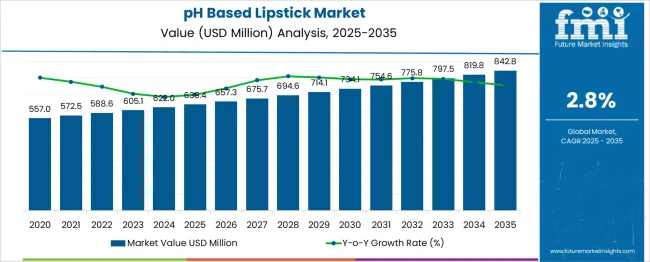
| Metric | Value |
|---|---|
| pH Based Lipstick Market Estimated Value in (2025 E) | USD 639.4 million |
| pH Based Lipstick Market Forecast Value in (2035 F) | USD 842.8 million |
| Forecast CAGR (2025 to 2035) | 2.8% |
The pH based lipstick market is growing steadily as consumers seek personalized beauty products that adapt to individual skin chemistry. Industry observations have noted increasing consumer interest in lipsticks that change shade according to the wearer’s pH level, offering a unique and customized look.
Advances in cosmetic formulations have enabled brands to develop products with stable pigments that react predictably to skin pH variations. The rising demand for long-lasting and skin-friendly makeup products has further accelerated adoption. Social media trends and influencer endorsements have enhanced product visibility and consumer trial. Consumers are increasingly drawn to lipsticks that combine color innovation with comfort and skin safety. The market is expected to expand further as brands continue to improve formulation technologies and diversify product offerings. Growth is anticipated to be driven by bullet lipstick formats, matte finishes, and synthetic ingredient-based formulations, reflecting evolving consumer preferences and manufacturing efficiencies.
The pH based lipstick market is segmented by product type, finish type, ingredient, price range, and distribution channel and geographic regions. The pH-based lipstick market is divided by product type into Bullet lipstick, Liquid lipstick, Gel lipstick, and Others (powder, pencil, stick, etc.). In terms of finish type of the ph based lipstick market is classified into Matte, Cream, Glossy, Natural, Shimmery, and Others (metallic, sheer, plump up wet gloss etc.). Based on ingredient of the pH based lipstick market is segmented into Synthetic and Natural. By price range of the ph based lipstick market is segmented into Medium, Low, and High. By distribution channel, the pH based lipstick market is segmented into Offline and Online. Regionally, the pH based lipstick industry is classified into North America, Latin America, Western Europe, Eastern Europe, Balkan & Baltic Countries, Russia & Belarus, Central Asia, East Asia, South Asia & Pacific, and the Middle East & Africa.
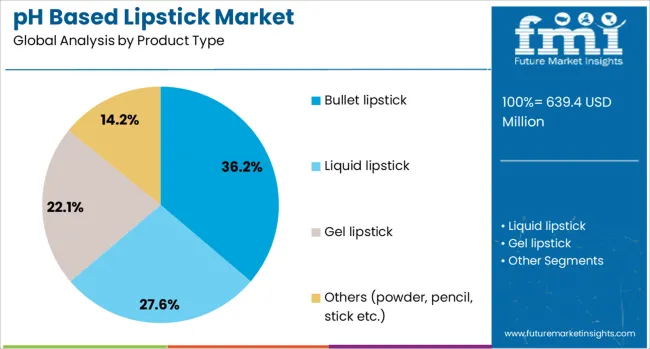
The bullet lipstick segment is projected to account for 36.2% of the pH based lipstick market revenue in 2025, maintaining its position as the dominant product type. This segment’s growth is attributed to the classic design and ease of application associated with bullet lipsticks. Consumers favor the tactile experience and control offered by the bullet form factor, which allows for precise and quick makeup application. The segment has benefited from ongoing innovation in texture and formulation that enhances comfort and wear time. Bullet lipsticks also appeal to a broad demographic, from everyday users to professional makeup artists. Their widespread availability and iconic status in the cosmetic industry support sustained demand. As personalization trends continue to grow, bullet lipsticks remain a preferred choice for PH based color-changing products.
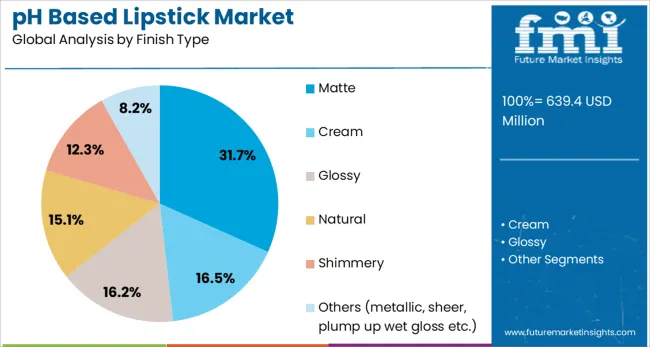
The matte finish segment is expected to hold 31.7% of the market revenue in 2025, establishing itself as a leading finish preference. Matte lipsticks are favored for their sophisticated look, long-lasting wear, and minimal transfer, making them popular for daily and formal use. The segment’s growth is supported by consumer preferences for lipsticks that offer a velvety texture without shine, aligning with contemporary beauty trends. Innovations have improved the comfort of matte lipsticks, reducing dryness and flaking.
Matte finishes also provide a strong color payoff that complements the pH reactive nature of these lipsticks. As the demand for versatile and enduring makeup solutions increases, the matte finish segment is expected to maintain its strong market position.
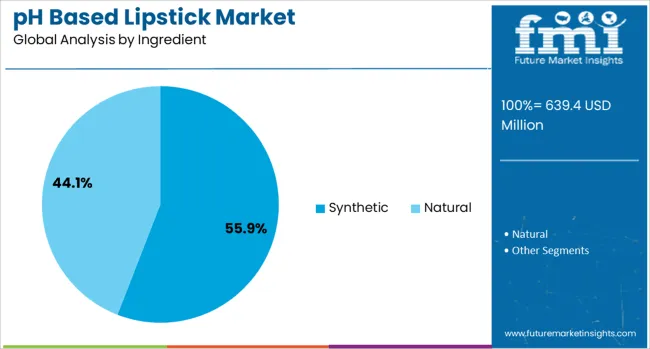
The synthetic ingredient segment is projected to hold 55.9% of the pH based lipstick market revenue in 2025, making it the leading ingredient category. Synthetic ingredients are preferred for their stability, color consistency, and ease of formulation in pH reactive products. These ingredients allow for precise control over the chemical reactions that produce color changes based on skin pH. Additionally, synthetic compounds contribute to product longevity and resistance to environmental factors such as heat and light. While natural ingredients remain popular for certain consumer groups, the performance benefits of synthetic materials have ensured their dominance in this market.
Manufacturers continue to optimize synthetic formulations to meet regulatory standards and consumer safety requirements. The synthetic ingredient segment is expected to retain its leading market share as pH-based lipsticks evolve.
pH based lipsticks are being favored for their ability to adjust shade based on the wearer’s lips, offering a personalized color experience without complex palettes. The product category combines moisture-balancing ingredients with mild acid-base indicators to create adaptive tints. Growing interest in multifunctional cosmetics has driven the development of lipsticks that offer hydration, SPF protection, and shade shifting in one formulation. Brands are launching marketing campaigns focused on fun customization and enriched botanical blends targeting younger consumers. Retail penetration has been supported through beauty retailer collaboration and influencer-led color reveal content.
pH-based lipsticks are being positioned as innovative cosmetic products that deliver personalized color by reacting to an individual’s skin pH and moisture levels. These formulations incorporate mild color-changing dyes within creams and balms enriched with ceramides and humectants, ensuring hydration alongside a dynamic visual effect. Consumer testing reports strong satisfaction, driven by the novelty of a hue that adapts throughout the day. Retail activation strategies include live demonstration booths that allow real-time color previews. Additionally, user-generated before-and-after content on social platforms has amplified organic reach, reinforcing pH-based lipsticks as a low-risk entry point for color experimentation.
Rising production of pH-based lipsticks is being driven by strong consumer interest in personalized cosmetics, prompting brands to scale operations despite technical hurdles. Manufacturers are investing in advanced emulsification techniques and stabilizer systems to improve dye stability and color consistency. Expanded pilot testing programs are being implemented to optimize shade predictability across diverse skin pH and moisture profiles. Strategic partnerships with raw material suppliers are helping secure compliant color additives, accelerating regulatory approvals in key markets. Increased automation in blending and filling lines is reducing batch variability, supporting large-scale commercialization while maintaining stringent quality and safety standards.
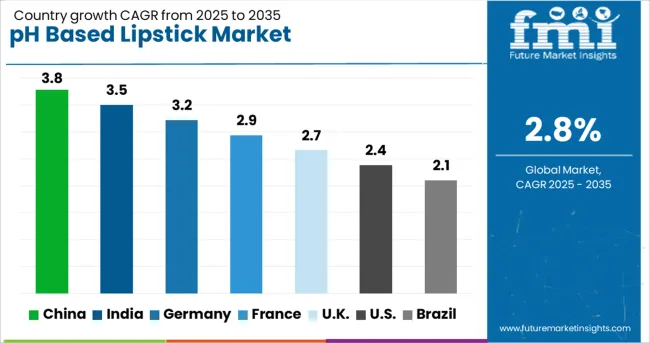
| Country | CAGR |
|---|---|
| China | 3.8% |
| India | 3.5% |
| Germany | 3.2% |
| France | 2.9% |
| UK | 2.7% |
| USA | 2.4% |
| Brazil | 2.1% |
The global pH-based lipstick market is projected to grow at a 2.8% CAGR from 2025 to 2035, driven by demand for color-adaptive lip products in premium and mass beauty segments. BRICS economies lead, with China at 3.8% and India at 3.5%, supported by growing cosmetic personalization trends and e-commerce-driven distribution. Among OECD nations, Germany records 3.2%, with a focus on dermatologically safe and multifunctional lip products, while France at 2.9% emphasizes luxury cosmetic innovation. The United Kingdom, at 2.7%, sees growth in clean-label and vegan-certified lipstick formulations across digital-first brands. The report includes an analysis of over 40 countries, with five profiled below for reference.
China is projected to grow at a 3.8% CAGR, driven by the rising popularity of color-adaptive lip products among younger consumers. Domestic brands are launching pH-sensitive lipsticks with long-lasting hydration and personalization features to meet consumer expectations. International cosmetic companies are investing in localized production and digital marketing to capture online beauty shoppers.
Premium segments are focusing on natural and vegan-friendly formulations to cater to ingredient-conscious consumers. E-commerce and social media platforms accelerate product discovery through influencer-led campaigns and AR-based virtual trials. Increasing demand for multi-functional lip products further drives category growth across retail and D2C channels.
India is forecast to grow at a 3.5% CAGR, supported by increasing demand for customized beauty products across urban and semi-urban markets. Domestic beauty brands are introducing pH-based lipsticks at affordable price points to appeal to mass consumers. Global brands emphasize premium offerings with long-wear technology and plant-based ingredients. E-commerce marketplaces dominate distribution, aided by influencer marketing and virtual try-on features. Growing interest in multifunctional products that combine hydration, SPF protection, and personalized color is expanding market reach. Strategic partnerships between cosmetic brands and retail chains enhance in-store visibility for premium lip care lines.

Germany is expected to grow at a 3.2% CAGR, with rising consumer preference for dermatologically safe, multifunctional cosmetics. Local and global players focus on premium pH based lipstick lines with clean-label formulations and high moisture retention. Demand for cruelty-free and vegan-certified lip products continues to rise among ethical beauty consumers. Drugstores and specialty retailers introduce private-label products to capture value-driven shoppers. The integration of digital beauty tools for shade personalization supports online purchases. Strong demand for multifunctional formats, combining pH adaptation with care benefits, is reinforcing innovation strategies across the German cosmetics market.
France is projected to grow at a 2.9% CAGR, driven by premium cosmetic brands leveraging pH-based lipstick technology for luxury segments. High-end formulations emphasize moisturizing properties, color precision, and allergen-free components. Digital-first marketing strategies, including influencer campaigns and AR-enabled shade selection, enhance consumer engagement in e-commerce channels. Local beauty manufacturers are launching eco-conscious packaging formats to appeal to sustainability-focused consumers. Cross-category innovation, such as lipsticks infused with skincare benefits, is reshaping premium beauty portfolios in France. An expanding demand for personalization in lip color offerings further supports growth.
The United Kingdom is expected to grow at a 2.7% CAGR, led by increasing interest in vegan-certified, clean-label cosmetic products. Digital-first beauty brands are leveraging influencer partnerships to promote pH-based lipsticks across social media platforms. Subscription beauty boxes are introducing customized lipstick shades, boosting category visibility among younger consumers. Retail innovation focuses on in-store digital tools for shade testing and virtual consultations. Premium brands highlight multifunctionality, offering hydration and SPF benefits alongside adaptive color technology. Rising demand for environmentally responsible products is encouraging the adoption of recyclable packaging solutions in the UK market.

L’Oréal leads the pH-based lipstick market, supported by advanced color-adaptive formulations and an extensive global distribution network. Bite Beauty and Christian Dior strengthen their positions with clean-label and luxury pH-reactive options catering to premium consumers. Clinique and MAC Cosmetics emphasize dermatologist-tested, high-performance variants focused on personalized beauty. Essence Cosmetics, Maybelline, and Renee Cosmetics target younger demographics with affordable, trend-driven products amplified through social media engagement.
Estee Lauder and Lipstick Queen innovate with hydration-infused pH technology for premium buyers. Urban Decay, Smashbox, and Tarte utilize influencer collaborations and eco-friendly packaging. Competition revolves around personalization, ingredient transparency, and strong digital marketing strategies to capture diverse consumer segments.
In Spring 2025, Dior expanded its signature Addict Lip Glow range with fresh, warm-toned, pH-activated shades. The balm adapts to each individual’s lips, offering customized color and hydration that lasts up to 24 hours.
| Item | Value |
|---|---|
| Quantitative Units | USD 639.4 Million |
| Product Type | Bullet lipstick, Liquid lipstick, Gel lipstick, and Others (powder, pencil, stick etc.) |
| Finish Type | Matte, Cream, Glossy, Natural, Shimmery, and Others (metallic, sheer, plump up wet gloss etc.) |
| Ingredient | Synthetic and Natural |
| Price Range | Medium, Low, and High |
| Distribution Channel | Offline and Online |
| Regions Covered | North America, Europe, Asia-Pacific, Latin America, Middle East & Africa |
| Country Covered | United States, Canada, Germany, France, United Kingdom, China, Japan, India, Brazil, South Africa |
| Key Companies Profiled | L'Oréal, Bite Beauty, Christian Dior, Clinique Laboratories, Essence cosmetics, Estee Lauder Companies, IBA cosmetics, Lipstick Queen, MAC Cosmetics, Maybelline, Renee Cosmetics, Robanda International, Smash box Beauty Cosmetics, Tarte, and Urban Decay Cosmetics |
| Additional Attributes | Dollar sales in the pH based lipstick market are driven by consumer demand for personalized beauty experiences. These lipsticks adapt to individual skin chemistry, providing a unique color for each user. The market is influenced by the growing popularity of clean, vegan, and cruelty-free cosmetics. Social media platforms play a significant role in promoting these products, especially among Gen Z and millennial audiences. Bullet lipsticks remain the dominant product type, while online retail channels are experiencing rapid growth. North America leads in market share, with the United States accounting for a significant portion. |
The global ph based lipstick market is estimated to be valued at USD 639.4 million in 2025.
The market size for the ph based lipstick market is projected to reach USD 842.8 million by 2035.
The ph based lipstick market is expected to grow at a 2.8% CAGR between 2025 and 2035.
The key product types in ph based lipstick market are bullet lipstick, liquid lipstick, gel lipstick and others (powder, pencil, stick etc.).
In terms of finish type, matte segment to command 31.7% share in the ph based lipstick market in 2025.






Full Research Suite comprises of:
Market outlook & trends analysis
Interviews & case studies
Strategic recommendations
Vendor profiles & capabilities analysis
5-year forecasts
8 regions and 60+ country-level data splits
Market segment data splits
12 months of continuous data updates
DELIVERED AS:
PDF EXCEL ONLINE
Phenolic Tackifying Resin Market Size and Share Forecast Outlook 2025 to 2035
Phenolic Adhesive Resin Market Size and Share Forecast Outlook 2025 to 2035
Pharmaceutical Zinc Powder Market Size and Share Forecast Outlook 2025 to 2035
Pharma Moisture Barrier Film Coating Market Size and Share Forecast Outlook 2025 to 2035
Pharmaceutical Grade Magnesium Sulfate Market Size and Share Forecast Outlook 2025 to 2035
Pharmaceutical Secondary Packaging Market Size and Share Forecast Outlook 2025 to 2035
Pharmaceutical Glass Packaging Market Size and Share Forecast Outlook 2025 to 2035
Pharmaceutical Manufacturing Equipment Market Forecast and Outlook 2025 to 2035
Physical Therapy Supplies Market Size and Share Forecast Outlook 2025 to 2035
Philippines Tourism Industry Forecast Outlook 2025 to 2035
Pharma and Healthcare Social Media Marketing Market Size and Share Forecast Outlook 2025 to 2035
Phenylethanol Market Forecast and Outlook 2025 to 2035
Phytopathological Disease Diagnostics Market Forecast and Outlook 2025 to 2035
Pharmaceutical Plastic Bottle Market Forecast and Outlook 2025 to 2035
Pharmaceutical Grade Sodium Carbonate Market Forecast and Outlook 2025 to 2035
Pharmaceutical Industry Analysis in Saudi Arabia Forecast and Outlook 2025 to 2035
Photoresist Chemical Market Forecast and Outlook 2025 to 2035
Photomask Inspection Market Forecast and Outlook 2025 to 2035
Pharmaceutical Packaging Market Size and Share Forecast Outlook 2025 to 2035
Phosphotungstic Acid Market Size and Share Forecast Outlook 2025 to 2035

Thank you!
You will receive an email from our Business Development Manager. Please be sure to check your SPAM/JUNK folder too.
Chat With
MaRIA